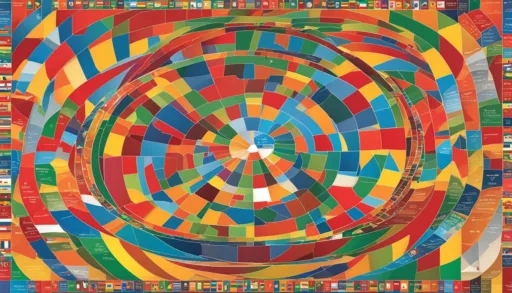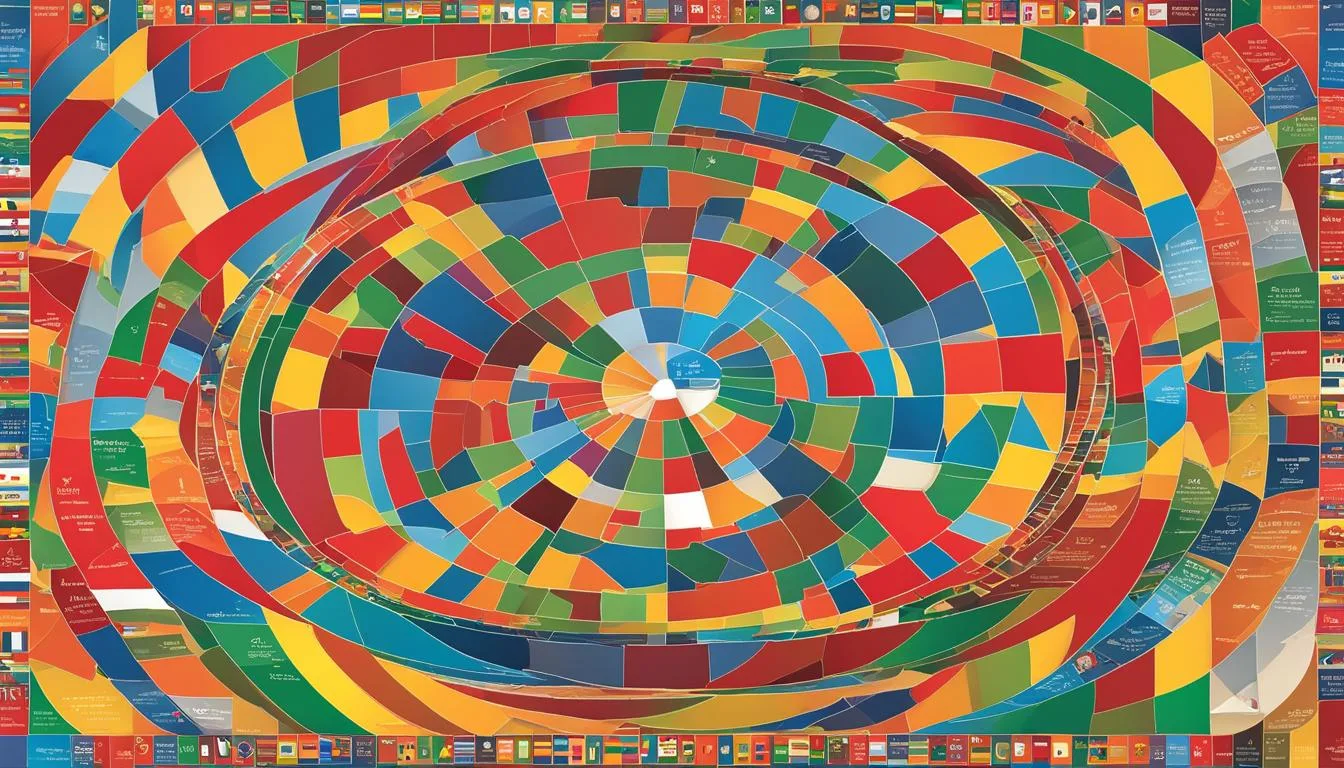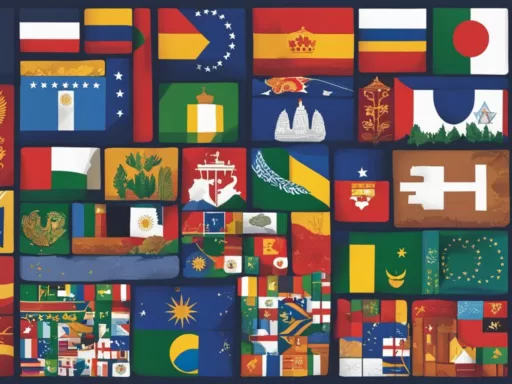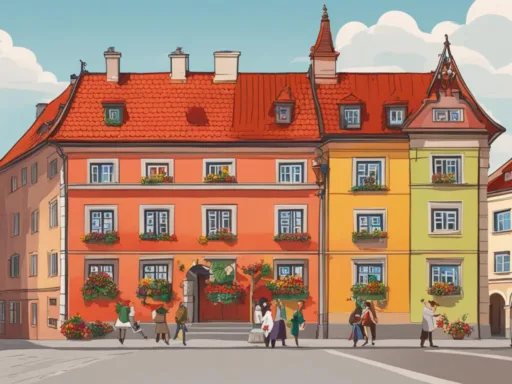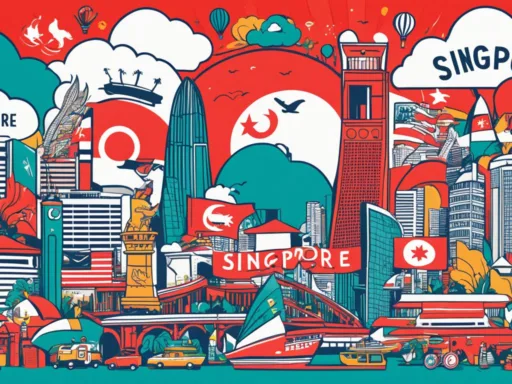Did you know that a nation roughly the size of Maryland is a crossroads of linguistic diversity, with a staggering 78.6% of its population speaking Romanian as of the 2014 Census? This nation is Moldova, where the blend of languages spoken in Moldova mirrors its rich cultural mosaic. At its heart lies Romanian, the star of Moldova’s official languages, but the linguistic spectrum of this Eastern European country doesn’t end there. Moldova’s history paints a picture of evolving Moldova linguistic diversity, where minority languages hold significant status and global tongues like English and French resonate with the future.
Key Takeaways
- Moldova’s primary language is Romanian, spoken by the majority of the population.
- Several minority languages, including Russian and Gagauz, are recognized and hold official status regionally.
- English and French are increasingly prominent in Moldova, contributing to its status as a polyglot nation.
- Moldova’s language policy recently reaffirmed Romanian as the state language in legislation.
- The country’s linguistic landscape is an embodiment of its complex political and cultural history.
- Linguistic diversity plays a critical role in identity and social dynamics within Moldova.
Understanding Moldova’s Linguistic Landscape
The tapestry of languages within Moldova mirrors the nuanced interplay of its history and ethnic groups. The official language, Romanian, serves as a cornerstone of national identity, but it’s the symphony of common languages in Moldova that illustrates the multicultural narrative of this nation. Alongside Romanian, Russian, English, French, and even Romanian sign language proliferate, each fulfilling unique functions and addressing the diverse needs within Moldovan society.
As we delve into Moldova language demographics, we uncover a landscape where multilingualism isn’t merely a convenience—it’s a vital element of daily life, from government and business to educational spheres and media outlets. This rich linguistic environment is indicative of Moldova’s adaptive, inclusive nature and its embedded traditions in communication and cultural interchange. Below is an at-a-glance snapshot of the country’s language use in various societal domains.
| Language | Percentage of Speakers | Primary Use |
|---|---|---|
| Romanian | 78.6% | Official language, Education, Media |
| Russian | 9.4% | Business, Intercultural Communication |
| English | Emerging now | International Business, Education |
| French | Widely studied | Diplomacy, Education |
| Other Minority Languages (e.g., Gagauz, Ukrainian) | Varies | Cultural Preservation, Regional Administration |
The convergence of diverse linguistic currents within Moldova’s borders exemplifies a broader trend towards globalization, yet it also maintains respect for the unique voice of every constituent language—a delicate balance many nations strive to achieve.
Moldova’s Official Language: Romanian or Moldovan?
In the heart of Eastern Europe, Moldova’s linguistic tapestry weaves a story of history, identity, and culture. A significant thread in this story involves the official language of the nation—a subject of much debate and policy. Is the correct term Romanian, or should Moldovan be considered a state language in its own right? This pivotal question connects deeply to Moldova’s language policy and has implications that resound through the country’s linguistic diversity and demographics.
The Historical Debate Over Moldova’s Official Language
The dispute over whether Moldova’s official language should be labeled Romanian or Moldovan is not merely semantic; it is steeped in historical context. In the Soviet era, Moldovan was considered a distinct language and was written using the Cyrillic alphabet. However, the linguistic authorities now recognize that the Moldovan dialects are variants of Romanian. This acknowledgement is central to the country’s language policy, which aims to preserve Moldova’s linguistic diversity while also emphasizing a shared heritage with neighboring Romania.
Latin vs. Cyrillic: Moldova’s Alphabet Evolution
Moldova’s transition from the Cyrillic to the Latin alphabet marked a significant turning point in its language map. This script reform, emerging from the 1989 state language law, symbolized a pivot towards the broader Romanian linguistic sphere. The Moldova language map illustrates that while the Latin script prevails, Cyrillic continues to maintain a foothold in certain regions like Transnistria, reflecting the layered Moldova linguistic diversity.
Implications of the Declaration of Independence on Language Identification
It was the Declaration of Independence in 1991 that crystallized Romanian as the official language of Moldova, a resolution further backed by rulings from Moldova’s Constitutional Court. Nevertheless, Moldova language demographics reveal a pluralistic society where self-identification often intersects with language preference, a fact that draws attention to the ongoing complexities within Moldova’s language policies and identity politics.
Linguistic Diversity: Minority Languages in Moldova
A vibrant spectrum of minority languages in Moldova mirrors the nation’s rich ethnic composition, offering a panoramic view of its societal frameworks. Understanding this aspect of Moldova’s cultural identity is akin to delving into a vividly painted Moldova language map, where each region adds a distinct hue to the overall linguistic landscape.
At the forefront, Russian stands out clearly, its prevalence undisputable with a 9.4% representation as the mother tongue of Moldovans. Russian’s significance is punctuated by its official status in administrative-territorial units, Gagauzia and Transnistria, regions where history and policy intertwine to uphold linguistic diversity.
- Gagauz, an equally integral thread in the tapestry, is the linguistic heart of the Autonomous Territorial Unit of Gagauzia, reflecting the unique identity of the Gagauz people.
- In regions with substantial Ukrainian communities, the Ukrainian language embroiders its own narrative into Moldova’s social fabric.
Such linguistic diversity underscores the multicultural essence and the societal importance of safeguarding this heritage. While Moldova continues to evolve, these minority languages reinforce the narrative of an inclusive, multifaceted, and interconnected society.
Below is a holistic view of Moldova’s key minority languages and their regional prevalence:
| Language | Region | Percentage of Speakers |
|---|---|---|
| Russian | Gagauzia, Transnistria, Others | 9.4% |
| Gagauz | Gagauzia | 4.6% |
| Ukrainian | Northern & Southern Moldova | 8.4% |
As we navigate the discussions on the future of Moldova’s linguistic journey, it is fundamental to acknowledge and appreciate the colorful mosaic of its language demographics. These minority languages not only serve as communicative tools but as living symbols of Moldova’s historical pathways and social jigsaw.
Moldova Language Map: Regional Language Distribution
Moldova’s tapestry of languages is a vivid reflection of its complex cultural and historical backdrop. As we delve into the country’s regions, we observe a distinctive array of linguistic patterns that contribute to the rich Moldova linguistic diversity. A cornerstone of this diversity can be observed in the autonomous territorial unit of Gagauzia and the de facto independent region of Transnistria, where languages spoken in Moldova are as diverse as the people themselves.
Language Use in Gagauzia and Transnistria
In Gagauzia, the Gagauz language predominates, serving as the mother tongue for the majority of local residents. This Turkish-derived language is indicative of the region’s distinct ethnic makeup. Moving eastwards to Transnistria, Russian takes a prominent role, holding official status and being a lingua franca for various ethnic groups.
Dialects: Variations of the Romanian Across Moldova
The Romanian language, while uniform in its literary form, exhibits a dynamic range of expressions through Moldovan dialects. These regional variants showcase the fascinating intralinguistic diversity within the country while maintaining intelligibility and connectivity among speakers across Moldova and Romania.
| Region | Dominant Language/Dialect | Notable Characteristics |
|---|---|---|
| Gagauzia | Gagauz | Turkic roots, Cyrillic and Latin scripts |
| Transnistria | Russian | Cyrillic script, Slavic influence |
| Northern Moldova | Moldovan Dialects of Romanian | Latin script, closer to standard Romanian |
| Central and Southern Moldova | Moldovan Dialects of Romanian | Specific phonetic and lexical characteristics |
It is through this lens of regional specificity that the country’s dialogue with its own identity continues to evolve, making the study of its language distribution not only a linguistic journey but also a cultural expedition.
languages spoken Moldova: The Role of Russian
The linguistic fabric of Moldova is rich and multifaceted, with the Russian language playing a pivotal role in the nation’s cultural and societal spheres. Being one of the common languages in Moldova, Russian is a key element in daily communication, widely spoken by various ethnic groups, and serves as a bridge of understanding among the diverse population. Its significance extends beyond its status as a minority language, functioning effectively as a lingua franca and highlighting its deep-rooted influence within Moldovan society.
- Officially acknowledged in autonomous regions such as Gagauzia and the de facto independent region of Transnistria.
- Used in government and legal institutions as a way of catering to Russian-speaking citizens.
- Prevalent in the media, with numerous publications and broadcasts available in Russian.
- Regarded as an important business language, facilitating trade and economic interactions with Russia and other Russian-speaking areas.
In educational systems, Russian is frequently taught and learned, signifying its status as an indispensable tool for future generations navigating a multilingual environment. The enduring Russian language in Moldova not only encapsulates the historical ties with the Eastern Slavic world but also mirrors the practical and integrative nature of language as a medium for connection in a diverse society.
Moldova’s Policy on Protecting Minority Languages
In the spirit of fostering Moldova’s linguistic diversity, the nation has established a framework to protect and promote minority languages in Moldova. This inclusive approach towards Moldova language policy manifests in several ways, addressing the needs of various ethnic communities and ensuring their languages’ survival and development in the modern landscape.
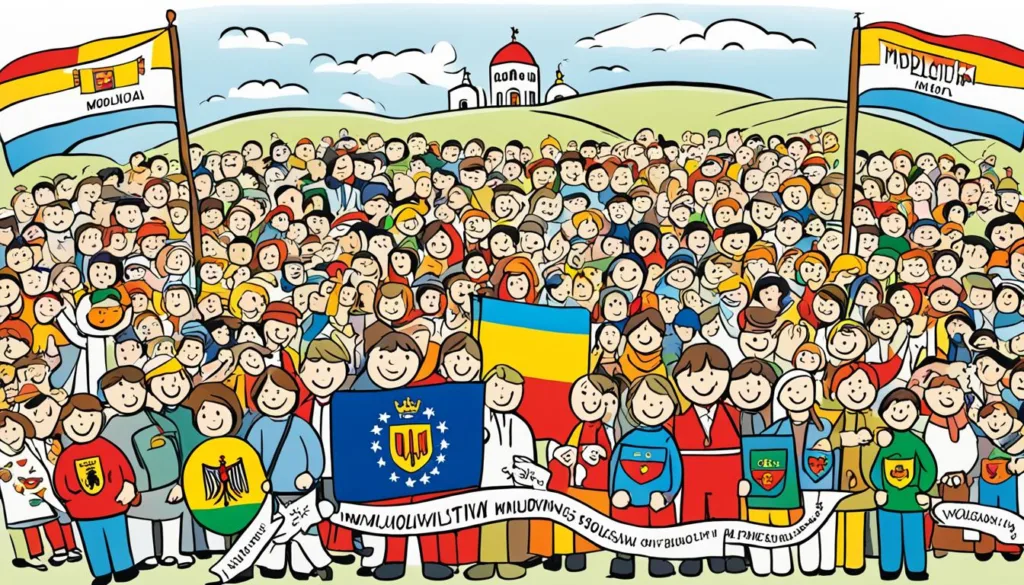
Legislation and Recognized Minority Languages
Moldova’s commitment to its linguistic heritage is evident through its legislative efforts. The government has passed laws providing official regional status to minority languages, which is a testament to the country’s respect for linguistic diversity. This legislation ensures that minority languages are not only a part of personal and cultural identity but also an active component in public administration, education, and media.
International Agreements and Minority Language Rights
The Republic of Moldova doesn’t stand alone in its quest to nurture minority languages—it has adhered to several international agreements focusing on protecting the rights of minority language speakers. These international commitments, coupled with earnest local efforts, form a robust bulwark guarding Moldova’s linguistic diversity. This dual approach guarantees that minority languages in Moldova are not merely acknowledged but also integrated into everyday life and afforded opportunities for growth and evolution.
Modern Dynamics: Foreign Languages Gaining Popularity
The linguistic landscape of Moldova is experiencing a fascinating shift as foreign languages, particularly English, begin to play a more integral role in the socio-economic fabric of the nation. As globalization continues to influence local cultures, Moldova is no exception. Migration and cross-border exchanges have brought a new dimension to Moldova’s language demographics, with the English language in Moldova emerging as a marker of progress and global connectivity.
The Rise of English as a Second Language
English has carved out a significant place in Moldovan society, especially among the youth and within academic institutions. It is now often the first choice as a second language, opening doors to international opportunities and fostering a more inclusive environment for foreign investors and tourists. Schools and universities are increasingly emphasizing fluency in English to prepare students for a dynamic world where English proficiency is frequently a prerequisite for professional success. This trend is a testament to the importance of the English language in Moldova and its role in shaping a future-oriented population.
The Influence of Migration on Language Practices
Moldova’s connection to a global diaspora has undeniably influenced its language practices. Moldovans overseas adapt to the languages of their new homes, and upon returning, often bring back linguistic influences that can enrich local dialects and communication styles. The influx of foreign languages in Moldova not only reflects migratory patterns but also points to the increasing fluidity with which cultures and languages interact in the modern era. It’s a phenomenon that underscores the diverse and evolving nature of Moldova’s linguistic identity.
This evolution is indicative of not just a change in the common languages in Moldova but is also representative of a broader cultural shift where the world’s interconnectedness turns language into a bridge rather than a barrier. Maintaining its linguistic heritage while embracing new tongues, Moldova is navigating the complexities of maintaining cultural authenticity amidst global influences.
Language Education in Moldova: A Focus on Multilingual Curriculum
Within the borders of Moldova, language education extends beyond the mastery of the official Romanian language, laying the foundation for multilingual curriculum within its educational institutions. This systematic approach to linguistic inclusion serves to equip the next generation with the critical language skills necessary for international dialogue and cultural exchange.

The strategic emphasis on Language education Moldova has resulted in a diversified educational framework, where students are encouraged to become proficient in several languages. Recognizing the value of linguistic versatility in the interconnected world, students in Moldova are often fluent in Romanian along with several other minority or foreign languages. This educational practice underscores a national vision that perceives language proficiency as a key to unlocking global opportunities.
- Romanian Language Studies – Ensuring proficiency in the official state language
- Minority Language Programs – Embracing the linguistic heritage of diverse ethnic communities
- Foreign Language Acquisition – Fostering competencies in internationally spoken languages
The intricate tapistry of languages represented within Moldova’s vibrant culture manifests itself in a curriculum designed to produce citizens capable of navigating a complex, multilingual world. This model of education is emblematic of Moldova’s broader societal intentions to promote inclusivity, respect for diversity, and international understanding through language education.
Impact of National Identity on Moldova Language Demographics
The interplay between national identity and the languages spoken in Moldova is particularly striking when examining the nation’s varied language demographics. The power of language as a symbol of identity is evident in societal and statistical representations of the Moldova linguistic diversity. When individuals partake in censuses or engage in conversations about their background, the choice of language they reference is strongly influenced by cultural, historical, and political factors.
Census and Controversies: Self-Identification and Language
Every census cycle in Moldova seems to spotlight the ongoing discussion on whether citizens identify their native tongue as Romanian or Moldovan. This matter is a manifestation of the broader debate regarding Moldova language demographics and is directly connected to historical context and territorial identities. Socio-political developments continue to shape individual choices in self-identifying one’s language, reflecting the historical tug-of-war between different cultural identities within this nation.
National Movements and the Role of Language as a Cultural Identifier
National movements in Moldova, focusing on reviving and strengthening indigenous culture, have consistently emphasized language as a cornerstone for cultural identity. These movements have not only fostered a renewed sense of patriotism but have also contributed to shaping the linguistic self-portrait of many Moldovans. Language, being more than a mere tool for communication, becomes intertwined with issues of self and collective identity, further influencing the Moldova official languages landscape.
Understanding the layers of Moldova’s language demographics is essential to appreciating the country’s rich cultural tableau. Such insight offers a clearer view of how languages spoken in Moldova are not just a matter of habit or practicality but rather intrinsic elements of the nation’s legacy and its people’s self-expression.
The Significance of Moldovan Dialects in the Romanian Language
The vibrant tapestry of Moldova’s linguistic heritage is notably marked by the Moldovan dialects of the Romanian language, which exhibit unique characteristics that mirror the country’s diverse cultural history. As we delve into the essence of these dialects, we find a world where language not only communicates but also connects and reflects the nation’s heart.
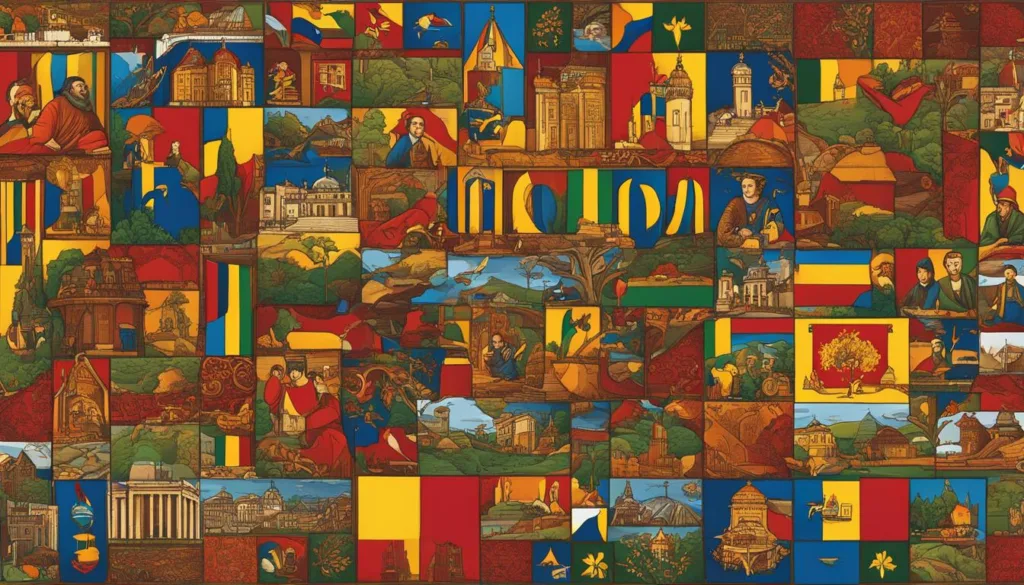
Characteristics of the Moldovan Dialect
The Moldovan dialects of Romanian are distinguished by particular phonetic, lexical, and syntactical elements, setting them apart from other regional forms. Interestingly, these adaptations have not barred understanding; rather, they enhance the richness of the Romanian language while preserving a sense of coherence within the Moldova official languages. This mutual intelligibility fosters a shared literary tradition that seamlessly crosses the borders between Moldova and Romania.
Perceptions and Political Context of the Moldovan Dialect
Over time, the Moldovan dialect has been cast in various lights, coloured by political and social perceptions. During the Soviet era, its status was elevated to that of a standalone language, stirring debates over Romanian cultural identity which persist in modern political discourse. These ongoing discussions not only speak to academic interest but also signal the deep interweaving of language with nationalistic and cultural sentiments in Moldova.
| Feature | Moldovan Dialect | Standard Romanian |
|---|---|---|
| Phonetic Uniqueness | Specific vowel and consonant shifts | Standard phonetics of Romanian |
| Lexical Items | Inclusion of Slavic loanwords | Predominantly Latin-derived vocabulary |
| Syntactical Structures | Unique colloquial constructions | Consistent with literary Romanian |
| Mutual Intelligibility | Highly intelligible to Romanian speakers | Fully intelligible to Moldovan dialect speakers |
| Cultural Significance | Reflects Moldova’s historical ties with Eastern Europe | Symbolizes linguistic unity with Romania |
In exploring the Moldovan dialects, we uncover layers of meaning that transcend mere communication, revealing the profound tie between language and identity that continues to shape Moldova’s linguistic landscape.
Conclusion
The rich tapestry of languages spoken in Moldova is an eloquent testament to the country’s complex past and dynamic sociopolitical fabric. Romanian, the cornerstone of Moldova’s language policy, serves as more than just a means of communication; it’s a symbol of national unity and a bridge connecting the diverse populations within its borders. Recent legislative developments have cemented Romanian’s position in official discourse, reflecting a concerted effort to weave a more cohesive national narrative.
Yet, Moldova’s commitment to its linguistic heritage doesn’t stop at a single language. The official recognition and regional use of minority languages illustrate an acknowledgement of Moldova’s multifaceted identity. These languages—from Russian to Gagauz and Ukrainian—are essential to the Moldova linguistic diversity, offering insights into the nation’s multiethnic and multilingual character. As such, language in Moldova is not merely a tool for everyday interaction but is emblematic of the nation’s plurality and tolerance.
Looking ahead, Moldova’s linguistic landscape is poised to continue evolving, mirroring transformations in global and regional dynamics. Understanding the intricacies of this linguistic ecosystem offers a window into the societal changes and continuing discourse on identity and heritage in Moldova. It is clear that the language policies and practices of this vibrant nation will remain closely watched indicators of its cultural progression and the unifying elements of its past, present, and future.
FAQ
What languages are spoken in Moldova?
Romanian is the official state language of Moldova, natively spoken by a majority of the population. Other commonly spoken languages include Russian, Gagauz, Ukrainian, and Bulgarian. Minority languages have official status in certain regions, and languages like English and French are gaining prominence as second languages.
Is there a difference between Romanian and Moldovan?
The terms “Romanian” and “Moldovan” historically refer to the same language, though “Moldovan” was extensively used during the Soviet era. After Moldova’s Declaration of Independence in 1991, the official language was named Romanian. Linguistically, the Moldovan dialect is one of the variants of the Romanian language, not a separate language.
Has Moldova’s alphabet always been the same?
No, Moldova’s official language has transitioned from the Cyrillic to the Latin alphabet. This shift occurred following the 1989 language law, aligning Moldova’s script with that of standard Romanian. However, the Cyrillic alphabet is still in use in the breakaway region of Transnistria.
What minor languages have official status in certain regions of Moldova?
Russian is granted official status in regional administrations such as Gagauzia and Transnistria. Gagauz is the official language in Gagauzia, while Ukrainian and Bulgarian are also recognized in localities with significant populations speaking these languages.
How do language demographics vary across Moldova?
Moldova’s language map indicates a varied regional distribution of languages. Gagauzia is known for its Gagauz-speaking majority, and Transnistria recognizes Russian as an official language. Romanian, although official at the national level, is spoken alongside these regional languages.
What role does the Russian language play in Moldova?
Russian is a significant minority language in Moldova, serving not only ethnic Russians but also as a lingua franca among different ethnic communities. It is widely used in daily communication, media, and is recognized for regional administration in areas like Gagauzia and Transnistria.
How does Moldova protect its linguistic diversity?
Moldova has taken legislative actions to protect its linguistic diversity by granting official status to minority languages in respective regions, thus fostering linguistic inclusivity. Additionally, Moldova is a participant in international agreements that safeguard minority language rights, including the European Charter for Regional or Minority Languages.
Are foreign languages becoming more popular in Moldova?
Yes, English, in particular, is becoming increasingly popular as a second language, especially among younger generations and within the education system. Other foreign languages like French, Italian, and Spanish are also common due to economic ties and migration patterns.
What is the focus of language education in Moldova?
Language education in Moldova emphasizes multilingualism. Students are instructed in the official Romanian language with the integration of regional minority languages and foreign languages such as English, French, and Russian, reflecting Moldova’s commitment to fostering a polyglot society.
How does national identity affect language demographics in Moldova?
National identity profoundly influences language demographics in Moldova. Self-identification regarding language is often influenced by ethnic and cultural belonging, which can be observed in census data and is subject to political and social controversy. Moldovans may identify their language as Romanian or Moldovan, reflecting historical and cultural nuances.
What are the characteristics of Moldovan dialects?
Moldovan dialects, a branch of the East Romance languages, display distinct phonetic, lexical, and syntactical features that are unique to the region. Despite these differences, the literary form of the Moldovan dialects remains identical to Romanian, allowing for mutual intelligibility.
Has the political context influenced the perception of the Moldovan dialect?
Yes, the political context has significantly influenced the perception of the Moldovan dialect. During the Soviet period, Moldovan was promoted as a distinct language to foster a separate cultural identity. These political dynamics continue to affect how the Moldovan dialect is perceived in contemporary discussions about national identity.
